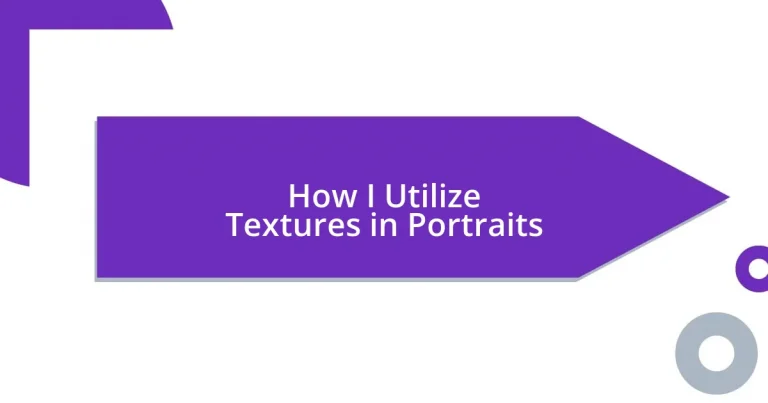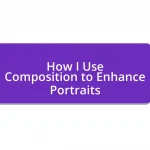Key takeaways:
- Textures in portraits add depth and character, enhancing emotional connection and storytelling.
- Choosing the right textures depends on the subject’s personality, with smooth textures evoking tranquility and rough textures adding complexity.
- Layering different textures, such as fabric and nature, creates rich narratives and enhances the overall visual impact of portraits.
- Effective lighting and focus techniques can dramatically transform the perception of texture, making the art more engaging and alive.

Understanding Textures in Portraits
Textures in portraits can transform an ordinary image into a captivating work of art. I recall a particular shoot where I deliberately focused on the roughness of an older subject’s skin. The unique lines and creases told stories of a life well-lived, revealing emotions that a smoother texture might obscure.
What I’ve noticed is that textures convey depth and character. Think about it: have you ever been drawn to a portrait because the textures evoke a feeling? That’s no coincidence. When I see the soft, luminous glow on a child’s face contrasting with the coarse, rugged fabric they’re wearing, I feel a visceral connection to both innocence and experience.
In my experience, incorporating various textures into portraits—like the softness of hair or the ruggedness of a background—enhances the narrative. I often experiment with lighting and angles to highlight these textured contrasts, creating a multidimensional effect. It’s fascinating how such elements can provoke emotions, inviting the viewer to linger a little longer on the portrait.

Choosing the Right Textures
When choosing the right textures for portraits, I always consider the subject’s personality. For example, a smooth texture may work beautifully for a joyful, serene subject, evoking a sense of tranquility. Conversely, when photographing someone with a more complex story, like a seasoned artist, incorporating rougher textures—perhaps the backdrop of a studio filled with brushes and paint—can add layers of meaning to the image.
I remember a session I had with a musician; the contrast between the smoothness of his face and the coarse, aged guitar he held told a compelling story. I deliberately chose to capture not just his expression but the worn-out details of the instrument, which hinted at years of passion and dedication. This interplay of textures enriched the portrait, creating a narrative that resonated beyond the visual.
To enhance my portraits further, I often experiment with how light interacts with different textures. A soft glow can transform a textured surface, emphasizing certain features while softening others. It’s a dance between light and texture that adds dimensionality, making the viewer almost instinctively feel the emotions behind the portrait.
| Texture Type | Perfect For |
|---|---|
| Smooth | Joyful, serene subjects |
| Rough | Complex stories, aged subjects |
| Soft | Childlike innocence |
| Coarse | Depth and experience |

Techniques for Incorporating Textures
When it comes to incorporating textures into my portraits, I rely heavily on layering techniques. For instance, I often intertwine natural elements with my subjects to create a rich tapestry of textures. One memorable session involved a young woman in a field of wildflowers, where I captured the soft petals contrasting with her denim jacket. This combination not only showcased her personality but also invoked a sense of freedom and joy.
- Layering: Combine different textures, like fabric and nature, to add depth.
- Contrast: Play with the juxtaposition of smooth and rough elements to tell a more complex story.
- Close-ups: Capture details of textured surfaces, like the intricate designs on clothing, to enhance the emotional connection.
Furthermore, I find that the process of texturing doesn’t just happen in-camera; it continues in post-processing. I enjoy using digital tools to emphasize or soften particular textures. I distinctly remember experimenting with this technique on a portrait of a painter against her vibrant artwork. By enhancing the brushstrokes while softening her features, I brought her passion to life, creating an emotional bridge between her and the viewers. These layers of manipulation make each portrait not only a visual delight but a narrative journey.

Tools for Texture Application
When it comes to texture application, my arsenal of tools primarily consists of a variety of brushes. I often find that using stiff bristle brushes can create highly expressive textures, perfect for infusing raw emotions into my portraits. One time, while working on a piece featuring an elder with deep-set wrinkles, I used a coarse brush to highlight the ruggedness of his skin, emphasizing a lifetime of experiences etched into every line.
Additionally, texture layers made of different materials play a crucial role in my work. I love experimenting with fabrics like burlap or lace, draped strategically around my subjects. I once wrapped a piece of delicate lace around a vibrant scarf during a shoot with a lively dancer; this interaction added a tangible feel of movement, enhancing the sense of motion in the final image. Have you ever considered how fabric can visually transform a portrait’s energy?
Finally, I lean heavily on my digital tools. Software like Photoshop is invaluable when fine-tuning textures for the final presentation. During one editing session, I vividly remember adjusting the grain on an image of a musician performing on stage. By amplifying the gritty texture of that venue, I not only preserved the authenticity of the moment but also created a visceral experience for anyone who saw the portrait—a reminder of the pulse and passion of live music.

Enhancing Portrait Depth with Textures
Textures really play a crucial role in enhancing depth within a portrait. I often think about how a small detail, like the slight fraying of a sweater or the delicate lace of a collar, can draw a viewer into the story behind the subject. I can recall a session with a musician; I positioned her against a weathered brick wall. The gritty texture of the wall added a layer of complexity to her polished appearance, almost suggesting a contrast between her dreams and the realities of her journey. Don’t you find it fascinating how textures can evoke different feelings in a portrait?
In some of my work, I discovered that utilizing the shadows created by textures can create an illusion of depth and dimension. For example, during a photoshoot for a local artist, I took close-up shots of her hands covered in paint. The roughness of her skin complemented the vivid colors in a way that conveyed both her passion and the tangible process of creating art. When I look at that portrait, I don’t just see her; I can almost feel the textures of her work and the dedication etched into every stroke.
Additionally, I often experiment with overlaying textured images during post-processing. One memorable instance was when I layered the intricate patterns from a vintage curtain over a portrait of a bride. The softness of the fabric contrasted beautifully with her radiant smile, fostering a sense of nostalgia and romance. Have you ever tried to layer textures in your images? It’s a delightful experiment that can add so much emotional depth.

Experimenting with Layering Textures
Experimenting with layering textures has become one of my favorite creative outlets. Recently, while photographing a dancer, I decided to layer soft, transparent fabrics over the image in post-processing. The results surprised me; the overlay not only enhanced the ethereal quality of her movements but also added an emotional weight to the portrait, as if she were suspended between reality and imagination. Have you ever thought about how a simple layer can drastically shift the mood of your artwork?
I remember another instance when I applied multiple layers of textured backgrounds during a shoot with a family. Each layer contributed to the storytelling aspect of the portrait. We started with a rustic wooden backdrop, then layered in touches of peeling paint from an old door and felted wool to evoke warmth and nostalgia. When I look at that photo, I can’t help but feel the love and history of their shared moments, woven together through texture. Isn’t it intriguing how these elements can build a bridge between the viewer and the subject?
One of the most rewarding aspects of layering textures is discovering unexpected combinations. During a recent project, I juxtaposed smooth, silky layers with rough, weathered surfaces, like pairing silk with bricks in my composition. This contrast not only made the portrait visually striking but also invited viewers to explore the complex stories behind each texture. It’s a reminder that art, much like life, thrives on contrasts—don’t you agree?

Showcasing Textured Portraits Effectively
When it comes to showcasing textured portraits effectively, the right lighting can make all the difference. I remember a shoot where I used soft, natural light filtering through a window for a young woman draped in a knitted shawl. The way the light danced across the textures created depth and brought the fibers alive, making the image feel almost tangible. Have you experienced how lighting can transform the way we perceive texture?
A key technique I often employ is to highlight textures through selective focus. During a portrait session with an elderly gentleman, I chose to focus on the intricate wrinkles of his hands, which told stories of a life well-lived. By blurring the background slightly, I drew attention to those textures that carried his history. It’s moments like these that remind me how details can profoundly impact storytelling—don’t you think we sometimes overlook the power of simplicity?
Moreover, incorporating natural elements into my portraits often elevates the textured experience. I vividly recall photographing a couple in a sun-kissed meadow. Their outfits were beautifully complemented by the grass and wildflowers around them, which added organic textures that harmonized with their joyful expressions. It made the portrait feel alive, creating a connection between the subjects and their surroundings. Isn’t it amazing how such simple additions can create a richer narrative and invite viewers to immerse themselves in it?














